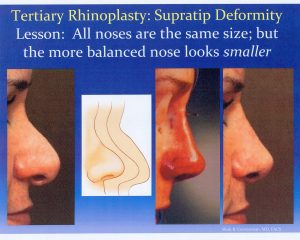Why Doesn’t My Nose Look Like The Simulation That The Doctor Created Before Surgery? Why Do I Have A Supratip Deformity?
I often see patients who bring with them beautiful simulations that their prior surgeons created to show their intended results, but the noses don’t look like that. Why not?
It is not as simple as poor skill on the surgeon’s part, though good technique certainly makes a difference. The reason that surgeons have less control than they would like over their postoperative results is based on one of the primary fallacies upon which rhinoplasty teaching and practice has always been based: If the surgeon makes a perfect skeleton, the skin will take on that shape. Unfortunately, it is not that simple.
Skin has its own vectors of contraction – – posteriorly and medially (backward and toward the midline) in the upper nose and concentrically and backward around the tip – – those are the vectors that create supratip deformity and make the tip look round and shapeless (in the Figure below, left and drawing). Skin can only contract a certain amount, and it will contract to its own natural shape, not necessarily to the shape that the surgeon made. If the skeleton is too small, the nose becomes shapeless. The treatment is bringing the skeleton up to the skin because the skin can’t tighten any further.
The skin, unfortunately for rhinoplasty surgeons and patients, is not a tablecloth. That is why I am such a proponent of closed rhinoplasty because it allows the surgeon to manipulate the skeleton but also see exactly how the skin is behaving: whether it is supported, whether the shape is proportionate, and whether the airway is open. This information is never available to the open rhinoplasty surgeon. If the soft tissues are stable and supported at the end of the operation (Figure, center and right), the result will be very close to what the surgeon sees (Figure, right). Notice that although all the noses are the same size, the postoperative nose looks smaller because the skin is supported in a more balanced way. The correction here was done with dorsal and tip grafts using rib cartilage. This is the part of nasal augmentation (or grafting) that is hard to understand unless you see it. Grafted noses should not look larger; they should look better-shaped.
Thus, the shape of the nose is not just the shape of the skeleton; the skin controls half of what the surgeon can achieve, which is why it is so important to be able to observe changes in nasal skin support, proportion, and contour during surgery; and that’s what allows surgeons to achieve what they wish to accomplish for their patients. That is one of the primary advantages of closed rhinoplasty. The nasal skin is not disturbed, so the surgeon can see what is happening.
If you have a supratip deformity or your tip has lost shape,
correction is still possible. See a surgeon who is experienced 
in revision rhinoplasty, whose results you like,
and whom you trust.